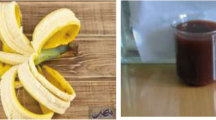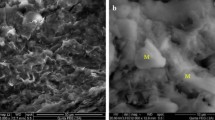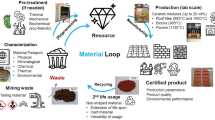Abstract
The black pottery unearthed from the Hanseong Baekje archaeological site in Seoul, South Korea was characterized by type using different techniques. The samples were classified into three types depending on their coloring pattern. There was no observable difference in the mineral and major element composition of the black colored part and raw material soil part of each sample. However, differences in magnetic properties and carbon content reflect the characteristics of each type and part of the sample. These results help to distinguish the mechanisms for black color development between reductive fired black pottery and soot-coated black pottery.







Similar content being viewed by others
References
Branfman S (2001) Raku: a practical approach. Krause publications, Iola
Watkins JC, Wandless PA (2006) Alternative kilns and firing techniques. Lark crafts, Asheville
Lazo E (2012) Naked Raku and related bare clay techniques. American ceramic society
Dassow SV (2013) Low-firing and burnishing. A & C Black publishers LTD, London
Hawley FM (1929) Prehistoric pottery pigments in the Southwest. Am Anthropol 31:731–754
Stewart JD, Adams KR (1999) Evaluating visual criteria for identifying carbon- and iron-based pottery paints from the four corners region using SEM-EDS. Am Antiq 64:675–696
Pendleton M, Washburn DK, Ellis EA, Pendleton BB (2012) Distinguishing between mineral paint and carbon paint on ancestral Puebloan pottery. Microsc Today 20:32–36
Pendleton M, Washburn DK, Ellis EA, Pendleton BB (2014) Comparing the detection of iron-based pottery pigment on a carbon-coated sherd by SEM-EDS and by Micro-XRF-SEM. Yale J Biol Med 87:15–20
Rosado L, Pevenage JV, Vandenabeele P, Candeias A, Lopes MDC, Tavares D, Alfenim R, Schiavon N, Mirao J (2017) Multi-analytical study of ceramic pigments application in the study of Iron Age decorated pottery from SW Iberia. Measurement 118:262–274
Spataro M, Cubas M, Craig OE, Chapman JC, Boroneant A, Bonsall C (2019) Production and function of Neolithic black-painted pottery from Schela Cladovei (Iron Gates, Romania). Archaeol Anthropol Sci 11:6287–6304
Gangas NHJ, Kostikas A, Simopoulos A, Vocotopoulou J (1971) Mössbauer spectroscopy of ancient Greek pottery. Nature 229:485–486
Kostikas A, Simopoulos A, Gangas NHJ (1974) Mössbauer study of ancient Greek pottery. J Phys 35:107–115
Kostikas A, Simopoulos A, Gangas NHJ (1974) Mössbauer study of Mycenean and Milnoan pottery. J Phys 35:537–539
Longworth G, Warren SE (1975) Mössbauer spectroscopy of Greek ‘Etruscan’ pottery. Nature 255:625–627
Nagy S, Kuzman E, Weiszburg T, Gyökeres-Tóth M, Riedel M (2000) Oxide transformation during preparation of black pottery in Hungary. J Radioanal Nucl Chem 246:91–96
Tite MS (2008) Ceramic production, provenance and use-A review. Archaeometry 50:216–231
Meirer F, Liu Y, Pouyet E, Fayard B, Cotte M, Sanchez C, Andrews JC, Mehta A, Scianu P (2013) Full-field XANES analysis of Roman ceramics to estimate firing conditions—A novel probe to study hierarchical heterogeneous materials. J Anal At Spectrom 28:1870–1883
Sciau P (2016) In: Dillman P, Bellot-Gurlet L, Nenner I (eds) Nanoscience and cultural heritage. Atlantis Press, Paris
Cauliez J, Manen C, Ard V, Caro J, Amara AB, Bocquet-Liénard A, Bruxelles L, Cantin N, Sacary X, Convertini F, Borgen V (2017) Technical traditions and pottery craftsmanship among the Woloyta and Oromo groups in Ethiopia. Bull Soc Prehist Fr 11:29–58
Epossi Ntah ZL, Sobott R, Fabbri B, Bente K (2017) Characterization of some archaeological ceramics and clay samples from Zamala - Far-northern part of Cameroon (West Central Africa). Cerâmica 63:413–422
Bouchez R, Coey JMD, Coussement R, Schmidt KP, Rossum V, Aprahamian J, Deshayes J (1974) Mössbauer study of firing condition used in the manufactured of the grey and red ware of Tureng-Tepe. J Phys 35:541–546
Bong WSK, Matsumura K, Nakai I (2008) Firing technologies and raw materials of typical early and middle Bronze Age pottery from Kaman-Kalehöyük; A statistical and chemical analysis. Anat Archaeol Stud 17:295–311
Noghani S, Emami M (2014) Mineralogical phase transition on sandwich-like structure of clinky pottery from Parthian Period, Iran. Period di Mineral 83:171–185
Venkatachalapathy R, Gournis D, Manoharan C, Dhanapandian S, Deenadayalan K (2004) FTIR and Mössbauer spectroscopic studies of archaeological potteries from Nathikudi, Tamilnadu. Indian J Phys 78:1371–1375
Venkatachalapathy R, Bakas T, Basavaiah, Deenadayalan K (2008) Mössbauer and mineral magnetic studies on archaeological potteries from Adhichanallur, Tamilnadu, India. Hyperfine interact 186:89–98
Manoharan C, Venkatachalapathy R, Dhanapandian S, Deenadayalan K (2007) FTIR and Mössbauer spectroscopy applied to study of archaeological artefacts from Maligaimedu, Tamilnadu, India. Indian J Pure Appl Phy 45:860–865
Wagner U, Gebhard R, Hausler W, Hufzelmann T, Riederer J, Shimada I, Sosa J, Wagner FE (1999) Reducing firing of an early pottery making kiln at Batan Grande, Peru: a Mössbauer study. Hyperfine Interact 122:163–170
Shimada I, Häusler W, Jakob M, Montenegro J, Riederer J, Wagner U (2003) Early pottery making in northern coastal Peru. Part IV: Mössbauer study of ceramics from Huaca Sialupe. Hyperfine Interact 150:125–139
Hayashida F, Häusler W, Wagner U (2003) Technology and organisation of Inka pottery production in the Leche valley. Part I: study of clays. Hyperfine Interact 150:141–151
Shimada I, Wagner U (2019) Technology and organization of black pottery production on the north coast of Peru. Boletín de Arqueología PUCP 27:133–156
Han YH (1986) The newly acquired bronze age artifacts of Chinju National Museum (1984–1985). Yeongnam Archaeol Rev 1:151–167
Shin KS, Oh MM (2010) The production and restoration of Bronze Age polished pottery through experimental archaeology. J Kor Field Archaeol 8:35–80
Nam SW (2013) As production technology, the meaning of the black burnished pottery in Baekje Dynasty. Kor Archaeol 89:94–137
Nam SW, Kim SK (2015) Research on the production technology of black-burnished pottery in Baekje period from the perspective of experimental archaeology. Ann Baekje 12:5–34
Jin WSJ (2016) The developmental study of interior ceramics which is using traditional smoked earthenware techniques. Wonkwang University, p 83
Choi SW, Lee NS, Lee JH, Lee HS, Chae SJ (2001) A study on the occurrence of Paekche burnished black pottery and their reproduction. Rev Cult Herit Stud 34:4–18
Kim SK, Han MS, Nam SW, Jang S (2017) Manufacturing characteristics of black burnished pottery from Pungnaptoseong, Beakje. J Conserv Sci 33:417–429
Koo HJ, Lee YJ, Kim SO, Cho HG (2018) Clay mineral distribution and provenance in surface sediments of Central Yellow Sea Mud. Geosci J 22:989–1000
Scheinost AC, Schwertmann U (1999) Color identification of iron oxides and hydroxysulfates: Use and limitations. Soil Sci Soc Am J 63:1463–1471
Taylor RM, Schwertmann U (1974) Maghemite in soils and its origin I: Properties and observation on soil maghemites. Clay Miner 10:289–298
Coventry RJ, Taylor RM, Fitzpatrick RW (1983) Pedological significance of the gravels in some red and grey earths of central North Queensland. Aust J Soil Res 21:219–241
Perrier N, Gilkers RJ, Colin F (2006) Heating Fe oxide-rich soils increases the dissolution rate of metals. clays clay miner 54:165–175
Chevalier R, Coey JMD, Bouchez R (1976) A study of iron in fired clay: Mössbauer effect and magnetic measurement. J Phys 37:861–865
Maniatis Y, Simopoulos A, Kostikas A (1983) Effect of reducing atmosphere on minerals and iron oxides developed in fired clays: the role of Ca. J Am Ceram Soc 66:773–781
Mackenzie KJD, Cardile CM (1990) A 57Fe Mössbauer study of black coring phenomena in clay-based ceramic materials. J Mater Sci 25:2937–2942
Maritan L, Nodari L, Mazzoli C, Milano A, Russo U (2006) Influence of firing conditions on ceramic products: Experimental study on clay rich in organic matter. Appl Clay Sci 31:1–15
Yu J, Han Y, Li Y, Gao P, Li W (2017) Mechanism and kinetics of the reduction of hematite to magnetite with CO-CO2 in a micro-fluidized bed. Minerals 7:209–220
Bellotto M, Gualtieri A, Artioli G, Clark SM (1995) Kinetic study of the kaolinite-mullite reaction sequence. Part I: kaolinite dehydroxylation. Phys Chem Miner 22:207–217
Campbell AS, Schwertmann U, Campbell PA (1997) Formation of cubic phases on heating ferrihydrite. Clay Miner 32:615–622
Acknowledgements
This study was supported by the National Research Institute of Cultural Heritage (NRICH) as part of the Cultural Heritage Research & Development program. We are deeply grateful to Prof. Chul Sung Kim at the Department of Nano-electro Physics, Kookmin University, for providing the Mössbauer data. We would also like to thank Sang Won Nam at NRICH and the two anonymous reviewers for their comments, which helped improve the manuscript significantly.
Author information
Authors and Affiliations
Corresponding authors
Additional information
Publisher’s Note
Springer Nature remains neutral with regard to jurisdictional claims in published maps and institutional affiliations.
Rights and permissions
About this article
Cite this article
Moon, D.H., Lee, M.S., Cho, H.G. et al. Magnetic and chemical characterization of black pottery from Hanseong Baekje archaeological site, South Korea. J Radioanal Nucl Chem 330, 419–426 (2021). https://doi.org/10.1007/s10967-021-07813-w
Received:
Accepted:
Published:
Issue Date:
DOI: https://doi.org/10.1007/s10967-021-07813-w




